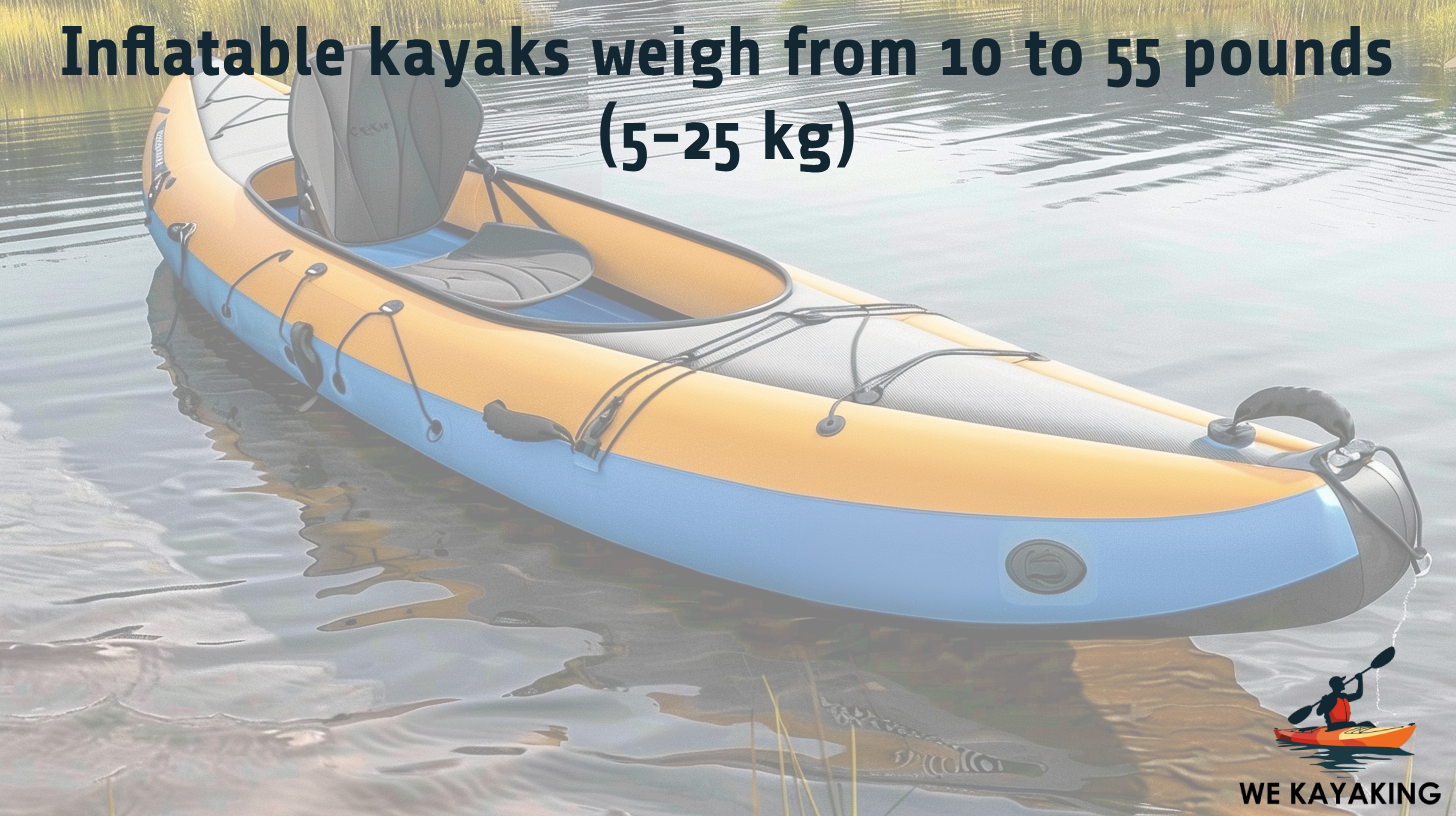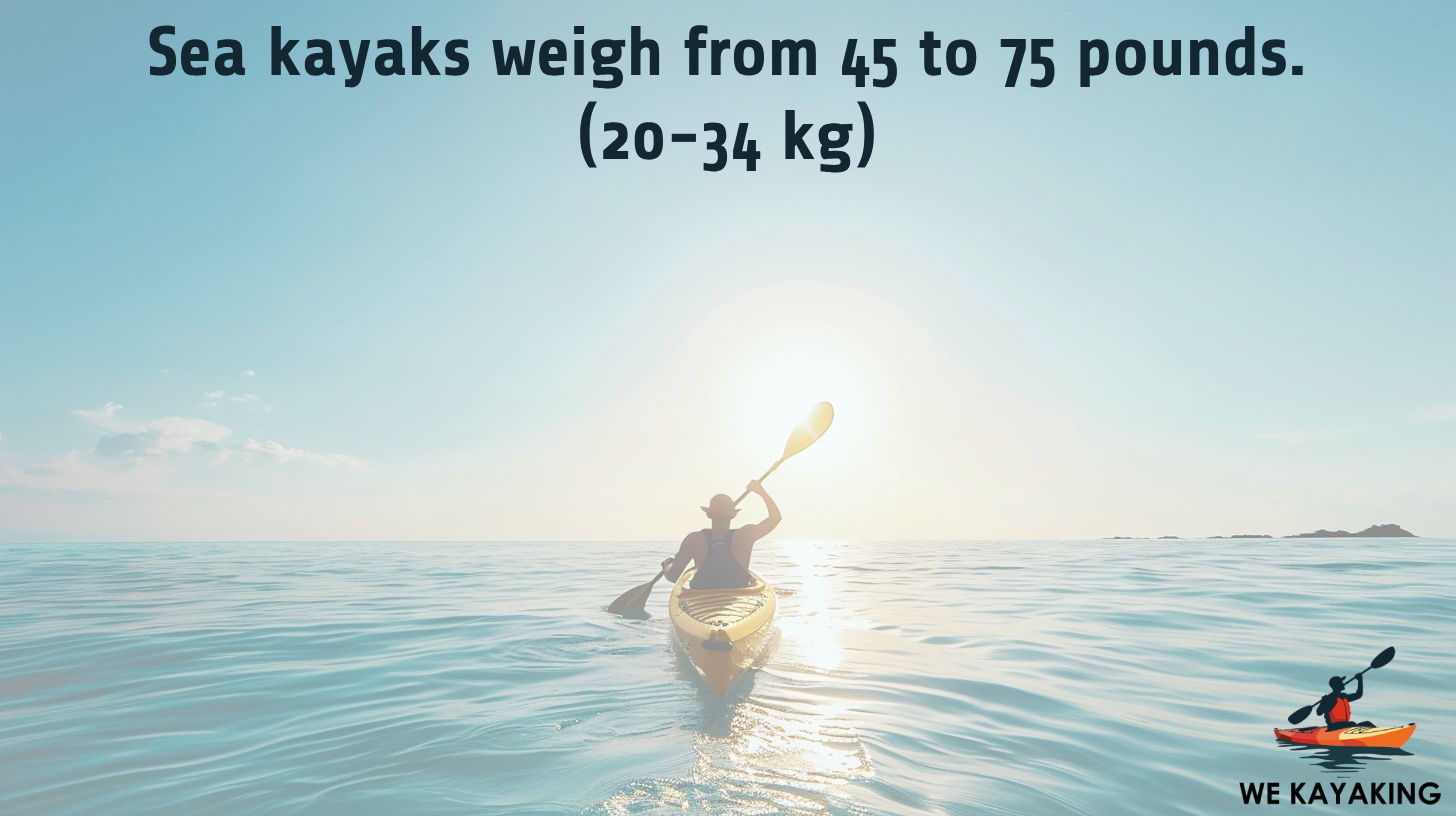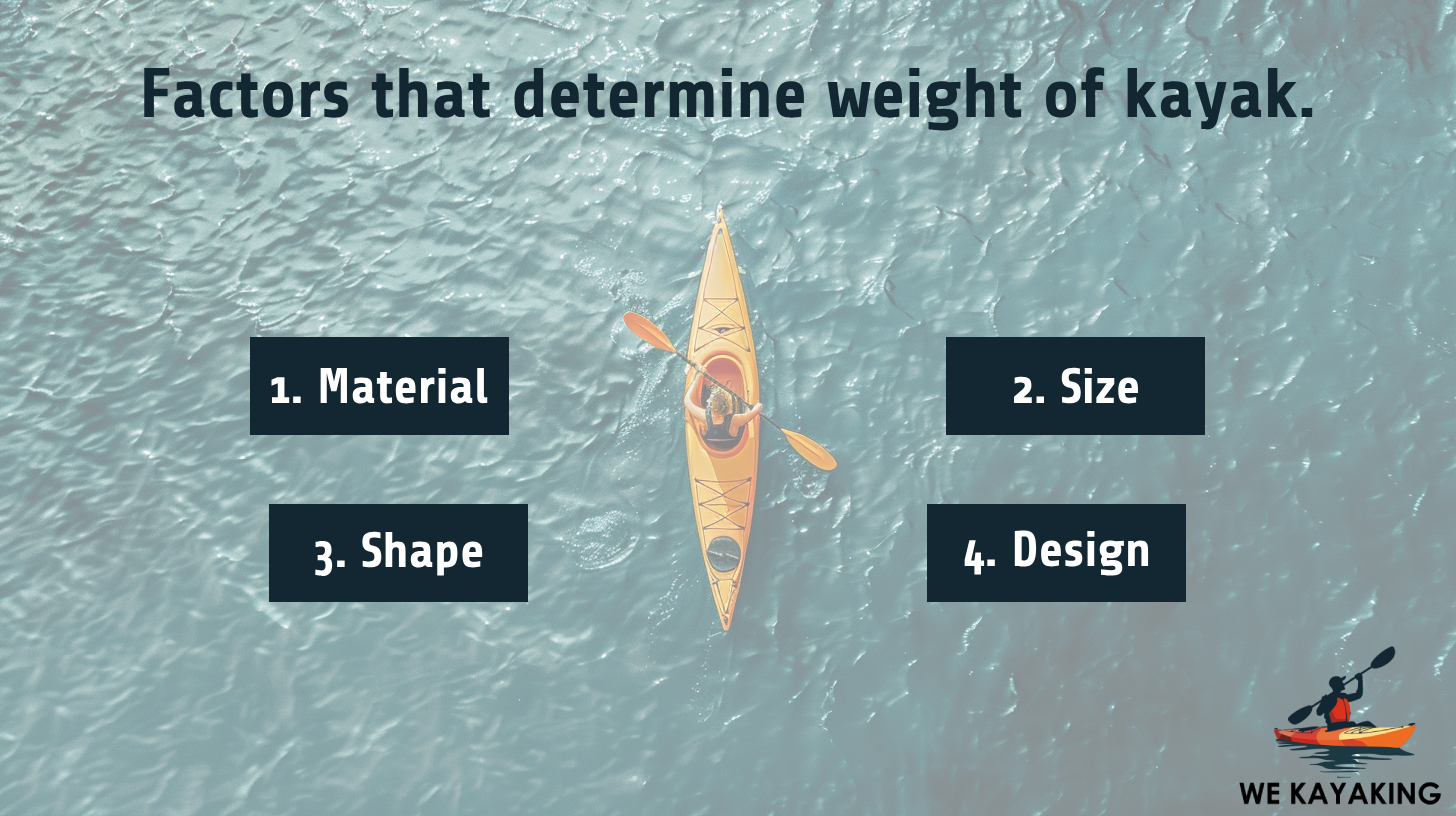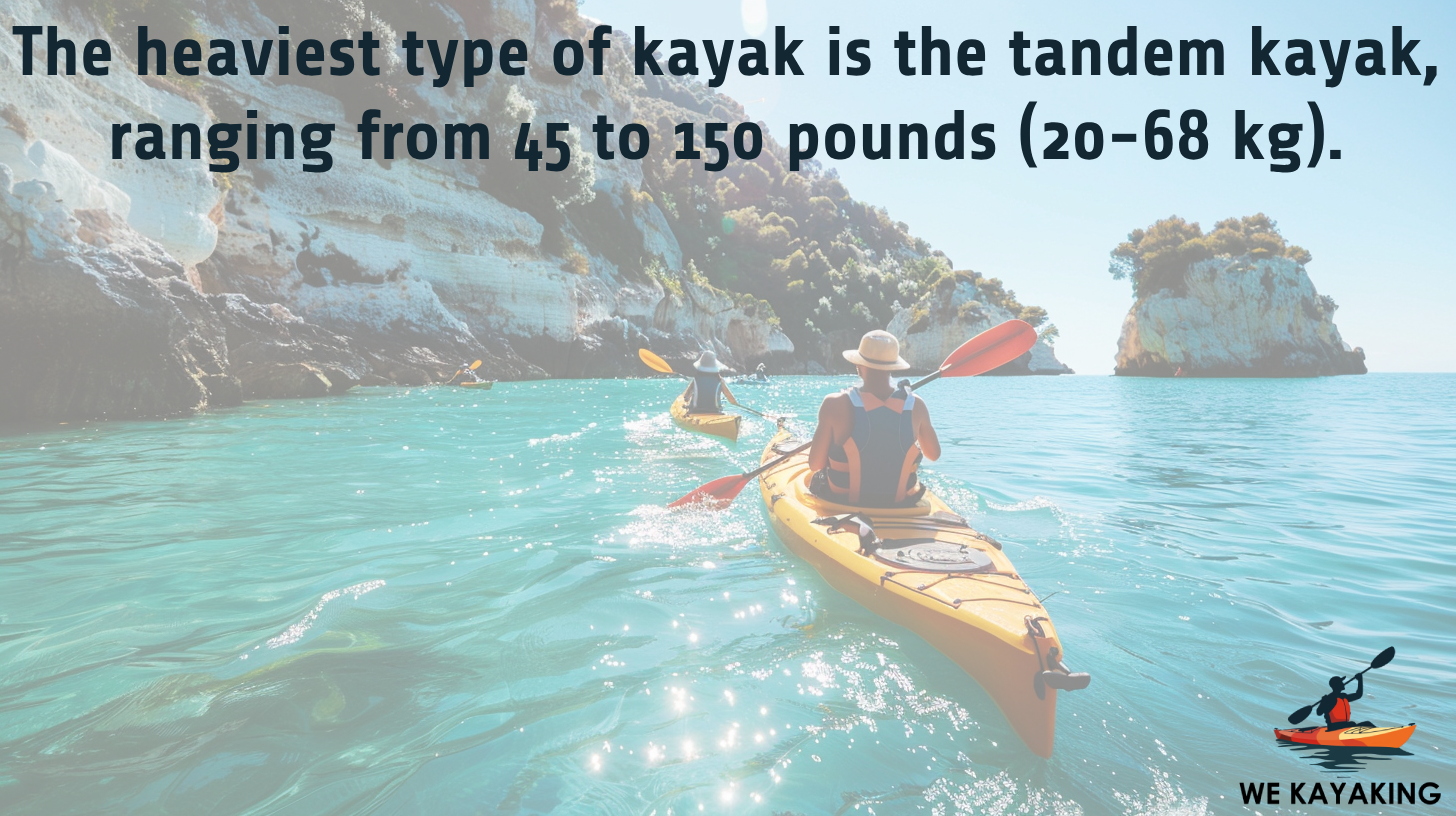
How Much Does a Kayak Weigh?
Kayak weight refers to the physical weight of the kayak itself, not including additional gear or equipment. It’s an important factor for transportation and handling, as a heavier kayak is more stable on the water but harder to carry and maneuver on land. Lighter kayaks are easier to transport and handle but are less stable and more susceptible to wind and currents. The weight of a kayak ranges from about 20 pounds (9 kg) for a small recreational kayak to around 100 pounds (45 kg) for a larger tandem or sea kayak.
Several factors contribute to the kayak’s weight, like type, material, size and added features. Recreational kayaks are lighter, usually between 20-40 pounds (9-18 kg), and designed for ease and stability, whereas touring or sea kayaks are built for endurance and speed, weighing between 35-70 pounds (16-32 kg).
Tandem kayaks, accommodating more than one person, are heavier, ranging from 60-100 pounds (27-45 kg). Material-wise, plastic or polyethylene kayaks are durable and heavier (40-80 pounds/18-36 kg), while composite kayaks made from fiberglass, Kevlar, or carbon fiber are lighter and range from 30-55 pounds (14-25 kg), with wooden kayaks falling in a similar range but requiring more maintenance.
The length and width of the kayak also play a significant role in its weight; the longer and wider it is, the heavier it usually is. Additional features like storage, seats, and fishing accessories further increase weight, especially in fishing kayaks that weigh between 40-100 pounds (18-45 kg) or more.
Table of Contents
How much does a 2 person kayak weigh?
A 2-person, or tandem kayak, is designed to accommodate two paddlers. This kayak weighs between 45 to 150 pounds (20-68 kg). The range depends on the tandem kayak’s material, design, and additional features. Inflatable tandem kayaks are generally much lighter than their hardshell counterparts, primarily due to the materials and the fact that air is the primary component providing buoyancy. Tandem kayaks tend to be heavier or lighter based on the materials used. Tandem kayaks made out of polyethylene/plastic tend to be heavier than those utilizing materials such as fiberglass or carbon fiber.
The length and width contribute significantly to the overall mass, especially as tandem kayaks are designed to be stable and spacious. Additional elements like comfortable seating, storage compartments, and fishing accessories increase the weight, while the intended use (recreational, touring, or fishing) further dictates the design and consequently the weight.
How much does an inflatable kayak weigh?
 An inflatable kayak’s weight is directly related to the materials used in its construction. The weight range is between 10 to 55 pounds (5-25 kg). This weight includes the fabric, seams, valves, and any built-in features like seats or storage areas.
An inflatable kayak’s weight is directly related to the materials used in its construction. The weight range is between 10 to 55 pounds (5-25 kg). This weight includes the fabric, seams, valves, and any built-in features like seats or storage areas.
The convenience of inflatable kayaks lies in their lightweight nature and the ease with which they are carried and stored, making them a popular choice for those with limited storage space. However, there is a disadvantage to the weight of inflatable kayaks - they aren’t able to withstand all the conditions that hard shell kayaks are able to.
How much does a sit-on kayak weigh?
A sit-on kayak weighs between 40 to 80 pounds (18-32 kg), depending on the size, style, and materials used. Smaller or more compact models are on the lighter end of this range, while larger, tandem, or fishing-specific models with extra features are heavier, sometimes exceeding 80 pounds (36 kilograms). Materials play a big role in weight; plastic models tend to be heavier, while composites like fiberglass or carbon fiber are lighter.
How much does a sit-in kayak weigh?
The weight of a sit-in kayak depends on the size, style, and materials used and is between 40 to 70 pounds (18-32 kg). Lighter kayaks are often made from composite materials like fiberglass or Kevlar and weigh on the lower end of that range, while heavier, usually more durable options are constructed from polyethylene and weigh more. Touring or sea kayaks are longer, equipped with additional features, and weigh a bit more, sometimes up to 60 pounds (27 kilograms) or more.
How much does a sea kayak weigh?
 The weight of a sea kayak ranges from 45 to 75 pounds (20-34 kg). Sea kayaks are designed for stability and performance in open water conditions and tend to be long and narrow. The construction material influences the weight: fiberglass, Kevlar, or carbon fiber sea kayaks are lighter (often on the lower end of the weight range), while plastic or polyethylene kayaks are heavier.
The weight of a sea kayak ranges from 45 to 75 pounds (20-34 kg). Sea kayaks are designed for stability and performance in open water conditions and tend to be long and narrow. The construction material influences the weight: fiberglass, Kevlar, or carbon fiber sea kayaks are lighter (often on the lower end of the weight range), while plastic or polyethylene kayaks are heavier.
How much does a river kayak weigh?
River kayaks weigh in the range of 15 to 60 pounds (14-27 kg), influenced by several factors including material, size, and design. These kayaks are shorter and more compact compared to their sea or touring counterparts, which affects their weight. Most are constructed from durable polyethylene, balancing toughness with a reasonable weight, although some higher-end kayaks utilize lighter materials like carbon fiber or fiberglass which overall makes them lighter.
What affects the weight of the kayak?
 The weight of a kayak is influenced by various factors, including material, size, shape, and the design of the kayak. The material plays a role, as polyethylene kayaks are heavier but more durable, while fiberglass, carbon fiber, and kevlar variants are much lighter.
The weight of a kayak is influenced by various factors, including material, size, shape, and the design of the kayak. The material plays a role, as polyethylene kayaks are heavier but more durable, while fiberglass, carbon fiber, and kevlar variants are much lighter.
The size and shape also contribute significantly; longer and wider kayaks designed for stability and capacity are naturally heavier, whereas shorter, narrower models are lighter and more agile.
Furthermore, the kayak’s design purpose affects its weight. Recreational kayaks tend to be bulkier and heavier to accommodate more gear and stability; sea kayaks are elongated and slender for efficiency over long distances; and specialized kayaks like whitewater models are compact and robust, with weight varying according to the specific performance requirements. Each of these aspects combines to determine the overall weight of the kayak, reflecting a balance between durability, performance, and portability tailored to the paddler’s needs.
Which kayak type is the most lightweight?
The lightest kayak is an inflatable kayak, ranging from 10 to 55 pounds (5-25 kg). These kayaks are made from lightweight materials like PVC or urethane and are deflated for easy storage and transportation. This feature is highly valued by those who prioritize ease of transport or have limited storage space.
However, while they excel in portability and weight savings, they lack the performance, speed, and durability of hard-shelled kayaks. This makes them ideal for calm waters and casual use but less suited for rough conditions or speed-intensive paddling.
Are lightweight kayaks faster?
Yes, lightweight kayaks are faster than their heavier counterparts. Less weight translates to less effort needed to move the kayak through the water, allowing for quicker acceleration and higher potential speeds. The reduced weight means less drag and resistance, easier paddling, and a faster increase in speed, which overall contribute to the speed of the kayak.
Are lightweight kayaks better?
There are certain advantages that lightweight kayaks offer over heavy ones. Lightweight kayaks offer advantages in transportation and storage, as they are easier to carry and handle, making them ideal for those with physical limitations or who frequently transport their kayak. They are also faster and more maneuverable, requiring less effort to paddle. I think the question of whether lightweight kayaks are better or not depends on factors such as convenience, performance, stability, durability, and budget.
Which kayak type is the heaviest?
 The heaviest type of kayak is the tandem kayak, ranging from 45 to 150 pounds (20-68 kg) in weight, designed to occupy more than one person at a time. The increase in size and capacity results in a heavier kayak overall. Hardshell tandem kayaks, particularly those made from durable materials like polyethylene, are among the heaviest options available due to the combination of size and material density.
The heaviest type of kayak is the tandem kayak, ranging from 45 to 150 pounds (20-68 kg) in weight, designed to occupy more than one person at a time. The increase in size and capacity results in a heavier kayak overall. Hardshell tandem kayaks, particularly those made from durable materials like polyethylene, are among the heaviest options available due to the combination of size and material density.
Are heavy kayaks safer?
Yes, heavy kayaks are safer. Heavy kayaks often provide more stability, especially in choppy waters or under heavy loads, which makes them feel safer for beginners or those paddling in rough conditions. Their weight helps lower the kayak’s center of gravity, contributing to better secondary stability and making them less likely to tip over.
Is it possible to lift the kayak by yourself?
Yes, it is possible to lift a kayak by yourself. This depends on your physical strength and the kayak’s weight. I do think many people are able to lift a lightweight or midweight kayak for short distances by themselves.
